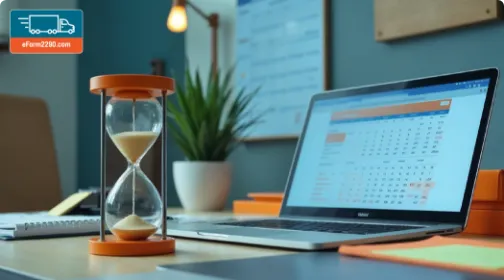What is VIN correction?
VIN correction refers to the process of amending a VIN that was entered incorrectly when filing Form 2290 HVUT (Heavy Highway Vehicle Use Tax Return) with the IRS.
VIN correction allows you to rectify an incorrect VIN on a previously filed Form 2290. The IRS requires the correct VIN to process heavy vehicle use tax (HVUT) filings. If a taxpayer mistakenly enters the wrong VIN on Form 2290, they must file a VIN correction to update the incorrect information on Schedule 1. This ensures accurate IRS records and compliance with tax regulations.
What is VIN?
A VIN (Vehicle Identification Number) is a unique 17-character alphanumeric code assigned to every motor vehicle when it’s manufactured. It acts like a fingerprint for the vehicle—no two vehicles have the same VIN.
When to file a Form 2290 VIN correction?
You should file a Form 2290 VIN correction when you discover that a VIN was entered incorrectly on an already accepted Form 2290 filing by the IRS.You need to file a VIN correction in the following cases:
- You mistyped the VIN on a previously accepted Form 2290 filing.
- The IRS has accepted your original Form 2290, but the wrong VIN appears on the stamped Schedule 1.
- You need a corrected Schedule 1 for purposes such as vehicle registration, renewal, or compliance.
Leaving a VIN error uncorrected could result in penalties or fines due to incorrect tax reporting. It may also create issues when transferring vehicle ownership, as the DMV requires a corrected Schedule 1 to issue a new title.
How to file a Form 2290 VIN correction?
To correct a VIN on your Form 2290, you’ll need to file a new Form 2290 with the correct VIN. Make sure to check the “VIN Correction” box and include both the original filing date and the incorrect VIN that was previously submitted.
While VIN corrections were once only accepted via paper forms, the IRS now allows electronic submissions for faster processing. With eForm2290, you can file online easily and receive your corrected Schedule 1 within minutes!
Fix VIN errors fast with eForm2290 – no paperwork, no delays! Get your updated Schedule 1 in minutes
How to e-file VIN correction with eForm2290?
Correcting a VIN with eForm2290 is a quick and hassle-free process. Follow these simple steps to e-File your VIN correction with eForm2290:
Access your eForm2290 account.
Click on ‘Make an Amendment’ and enter your reference number.
Enter the correct vehicle identification number (VIN) and submit the form.
Why VIN corrections with eForm2290?

100% Free VIN correction
Correct VIN errors at zero cost, even if filed elsewhere.

Easy E-filing
Complete VIN correction in minutes with a user-friendly interface.

Instant Return Status
Get real-time updates and IRS confirmation instantly.

Updated Schedule 1
Receive your corrected Schedule 1 in your inbox immediately.

Secure & Confidential
Your sensitive data is protected throughout the filing process.

Dedicated Support
Expert assistance whenever you need it.
Why are VIN corrections free with eForm2290?
VIN corrections are free with eForm2290 because the IRS allows taxpayers to correct an incorrectly reported VIN at no additional federal tax cost — and eForm2290 passes this benefit directly to users.
Correcting your VIN with eForm2290 is quick, effortless, and completely hassle-free. Our seamless platform lets you fix it in just a few simple steps. With an intuitive interface, instant IRS confirmation, and expert support, you can correct your VIN for free, ensuring compliance without any extra costs or penalties.
Frequently asked questions on Form 2290 VIN correction
Where can I find the VIN of my vehicle?
- Your vehicle insurance policy documents
- Vehicle registration paperwork
- The driver's side door frame (on a metal plate)
- The side panel of the cab door
- The dashboard, visible through the windshield
- The owner's manual
- The dealer invoice
- The sales receipt from the seller
Can I correct the VIN on Form 2290 after the filing deadline has passed?
Are there penalties for not correcting a VIN on Form 2290?
What information is required for a VIN correction on Form 2290?
- The incorrect VIN that was originally filed.
- The correct VIN you want to update.
- Details about the vehicle, including its taxable gross weight.
- The tax period for which you’re making the correction.
- A short explanation of why the correction is needed.




